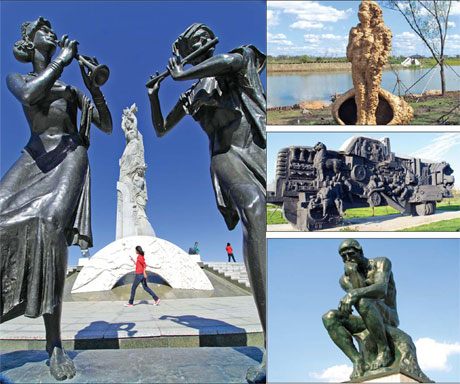Carved in stone - and more
Updated: 2011-12-15 13:19
By Raymond Zhou and Liu Mingtai (China Daily)
|
|||||||||
 |
|
Clockwise from left: The centerpiece at Changchun World Sculpture Park is a 23.5-meter obelisk with three maidens. Zhu Wanchang / For China Daily Golden Venus, a bronze work by Bertrand Ney, of Luxembourg. A relief showing the condensed history of China's wheeled vehicles. Auguste Rodin's Thinker. Photos by Raymond Zhou / China Daily |
One way of understanding Changchun and its global vision is through the thousands of sculptures that bedeck the landscape. Raymond Zhou and Liu Mingtai report.
There are many sculpture parks throughout China, but nowhere is as passionate about this form of artwork display as the capital city of Jilin province. Nor is any other locale as diverse in style.
There is the statue of Apollo on Culture Square, au naturel a la ancient Greece, yet with arms outstretched in Soviet athleticism - and back-to-back with a reclining Goddess of Moon and in line with the yin-and-yang complementary arrangement of China. There is the silhouette of two cyclists in stainless steel, appropriately outside the city stadium. Auguste Rodin's Thinker and The Age of Bronze greet visitors to the Changchun World Sculpture Park.
Well, the 92-hectare park is the natural choice for most people, locals and tourists alike, as it is conveniently located at the south end of the axis road.
Since it opened in 2003, it has been graced by more than 1 million visitors, who can either browse the exhibition halls where 300-plus pieces are on display (with 1,000 in the collection) or wander along the quiet paths to discover the 448 more that accentuate the tapestry of nature.
You may not find every piece to your fancy, but on the other hand you'll surely find something to your liking.
I was fascinated by a bronze bust of Shakespeare, with his left hand holding a quill pen and his face wearing an expression that's half pensive and half roguish.
The centerpiece of the park is a 23.5-meter obelisk with three maidens, each representing peace, friendship and springtime. It sits on a 6-meter platform in the shape of a blossoming flower. The five petals point to five smaller statues portraying the theme of music making from the five continents, forming a square of 48 meters in diameter.
This study in global unison is quite typical of the Chinese aesthetic, combining Western classicism with Chinese touches, State-sanctioned ideology with mass appeal. However, personal visions do have their place here and in other parts of the city.
I was taken on a tour of the 10-sq-km wetland park in northeastern Changchun. The park is so vast that we had to use a cart and got just a glimpse of most of the 107 statues chosen for the annual sculpture show.
Incidentally, our cart stopped in front of Golden Venus, a bronze work by Bertrand Ney, of Luxembourg. Suffice it to say, it is not a representation of feminine beauty by Chinese standards. Venus seems to have just climbed out of a mud fight. Some in our group muttered.
To me, it is testament to the degree of artistic diversity endorsed by the city authority.
It is obvious Changchun wants all geographic origins represented in its sampling of sculptural styles and themes. That policy gives its sculpture selections a cosmopolitan flair. The downside, if it can be so called, is an absence of consistency.
But that's not so at the new automotive park. There, whether it stands high or lies down, a sculpted work is in service of the automotive glory.
Changchun, as China's Motown, is extremely proud of having produced some of the most iconic vehicles in China, such as the first Red Flag limousine and the first Liberation truck.
On a walk of fame, dozens of the world's most significant vehicles and their makers are engraved.
A wall in the shape of an automobile turns out to be a relief of the condensed history of China's wheeled vehicles, starting with the horse-drawn carriage. It beats reading a book or even a visit to a museum. The park offers both education and entertainment to those who are thirsty for knowledge or who take it for granted.
Did you know the name of "China's father of the auto industry"? I hadn't heard of him until my trip to the park. His name is Rao Bin (1913-1987).
In 1953, he dug the first shovel of dirt for the foundation of what later became the First Automobile Works (FAW). In 1964, he was responsible for founding the Second Auto Works.
In his last public speech, for the 30th anniversary of the development of the Liberation truck, he said: "I'm too old to participate in the third venture, but I'm willing to be a bridge upon which you'll cross and build the vehicles of our dreams - the dream of several generations of Chinese."
Tears rolled down his cheeks as he uttered these words.
The statue shows him in an overcoat, holding a cane, looking forward. Behind him is an oversized pillar of the FAW logo.